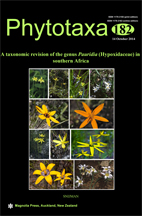Abstract
Pauridia, a genus confined to southern Africa, Australia, Tasmania and New Zealand, is distinguished from other genera of Hypoxidaceae by the synapomorphic mucilage canals above the vascular bundles of the leaves and the disulcate, micro-echinate pollen grains, apart from the secondarily derived trisulcate state in one of the Australian species. The majority of species (86%) are endemic to southern Africa, mostly in seasonally damp sites within the winter rainfall and all-year-round rainfall regions of Namibia and South Africa. The Australian, Tasmanian and New Zealand taxa were revised by Henderson (1987) and the African taxa were revised by Nel in 1914. The difficulties of applying Nel’s classification to the wealth of new material collected within the last century duly prompted a revision of Pauridia in southern Africa. Thirty species and three subspecies are recognised in this work, which includes a key to the species and full descriptions of all the southern African taxa, together with the updated nomenclature, geographic distribution, discussion on diagnostic characters and putative relationships of each. Four new species, P. breviscapa, P. maryae, P. monticola, and P. pudica and two new subspecies, P. monticola subsp. nubigena, P. gracilipes subsp. speciosa are described and illustrated, adding to the four other southern African species described subsequent to Nel’s revision. P. acida, a high altitude species that appears to flower after fire, remains poorly understood and one taxon, though almost certainly distinct, has been left unnamed until more complete material becomes available. The study of morphology, leaf anatomy and seed micromorphology suggests that the floral bracts and seeds are most helpful in revealing putative relationships among species. These characters are nevertheless insufficiently discrete to allow the recognition of formal infrageneric taxa. The northwestern and southwestern Cape has the highest concentration of species and according to IUCN criteria is home to three Endangered species (P. canaliculata, P. maximiliani, P. pygmaea) and two Vulnerable species (P. alba, P. linearis), found mainly in the lowland areas where natural habitats have been extensively fragmented.

